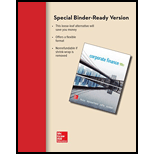
Loose Leaf for Corporate Finance (Mcgraw-hill/Irwin Series in Finance, Insurance, and Real Estate)
11th Edition
ISBN: 9781259709685
Author: Stephen A. Ross Franco Modigliani Professor of Financial Economics Professor, Randolph W Westerfield Robert R. Dockson Deans Chair in Bus. Admin., Jeffrey Jaffe
Publisher: McGraw-Hill Education
expand_more
expand_more
format_list_bulleted
Textbook Question
Chapter 10, Problem 17QP
Return Distributions Refer back to Table 10.2. What range of returns would you expect to sec 68 percent of the time for long-term corporate bonds? What about 95 percent of the time?
Expert Solution & Answer
Want to see the full answer?
Check out a sample textbook solution
Students have asked these similar questions
a. What is the price (expressed as a percentage of the face value) of a 1-year, zero-coupon corporate bond with a AAA rating and a face value of $1,000?
b. What is the credit spread on AAA-rated corporate bonds?
c. What is the credit spread on B-rated corporate bonds?
d. How does the credit spread change with the bond rating? Why?
Note: Assume annual compounding.
A corporate bond is quoted at a price of 98.96 and has a coupon rate of 4.7 percent, paid annually. What is the current yield?
a. 5.36 percent
b. 4.75 percent
c. 4.85 percent
d. 4.24 percent
e. 5.62 percent
A company's 5-year bonds are yielding 9% per year. Treasury bonds with the same maturity are yielding 5.1% per year, and the real risk-free rate (r*) is 2.35%. The average inflation premium is 2.35%, and the maturity risk premium is estimated to be 0.1 × (t - 1)%, where t = number of years to maturity. If the liquidity premium is 0.9%, what is the default risk premium on the corporate bonds? Round your answer to two decimal places.
Chapter 10 Solutions
Loose Leaf for Corporate Finance (Mcgraw-hill/Irwin Series in Finance, Insurance, and Real Estate)
Ch. 10 - Investment Selection Given that RadNet was up by...Ch. 10 - Investment Selection Given that Transocean was...Ch. 10 - Risk and Return We have seen that over long...Ch. 10 - Prob. 4CQCh. 10 - Effects of inflation Look at Table 10.1 and Figure...Ch. 10 - Risk Premiums Is it possible for the risk premium...Ch. 10 - Prob. 7CQCh. 10 - Returns Two years ago, the Lake Minerals and Small...Ch. 10 - Prob. 9CQCh. 10 - Historical Returns The historical asset class...
Ch. 10 - Calculating Returns Suppose a stock had an initial...Ch. 10 - Calculating Yields In Problem 1, what was the...Ch. 10 - Calculating Returns Rework Problems 1 and 2...Ch. 10 - Prob. 4QPCh. 10 - Prob. 5QPCh. 10 - Bond Returns What is the historical real return on...Ch. 10 - Calculating Returns and Variability Using the...Ch. 10 - Risk Premiums Refer to Table 10.1 in the text and...Ch. 10 - Prob. 9QPCh. 10 - Prob. 10QPCh. 10 - Calculating Real Rates Given the information in...Ch. 10 - Holding Period Return A stock has had returns of...Ch. 10 - Prob. 13QPCh. 10 - Prob. 14QPCh. 10 - Calculating Returns You bought a stock three...Ch. 10 - Calculating Real Returns Refer to Table 10.1. What...Ch. 10 - Return Distributions Refer back to Table 10.2....Ch. 10 - Prob. 18QPCh. 10 - Calculating Returns and Variability You find a...Ch. 10 - Arithmetic and Geometric Returns A stock has had...Ch. 10 - Arithmetic and Geometric Returns A stock has had...Ch. 10 - Calculating Returns Refer to Table 10.1 in the...Ch. 10 - Prob. 23QPCh. 10 - Using Return Distributions Suppose the returns on...Ch. 10 - Using Return Distributions Assuming that the...Ch. 10 - Prob. 26QPCh. 10 - Using Probability Distributions Suppose the...Ch. 10 - Prob. 28QPCh. 10 - Prob. 1MCCh. 10 - Prob. 2MCCh. 10 - Assume you decide you should invest at least part...Ch. 10 - Prob. 4MCCh. 10 - A measure of risk-adjusted performance that is...Ch. 10 - What portfolio allocation would you choose? Why?...
Knowledge Booster
Learn more about
Need a deep-dive on the concept behind this application? Look no further. Learn more about this topic, finance and related others by exploring similar questions and additional content below.Similar questions
- An investor gathers the following data on three newly-issued bonds: 1-year government bond, 3.0% yield 1-year ABC corporate bond, 4.2% yield 10-year government bond, 3.8% yield If investors require a 0.5% liquidity premium for corporate bonds, what are the components of the required return on a 10-year ABC bond?arrow_forwardA company’s 5-year bonds are yielding 7% per year. Treasury bonds with the same maturity are yielding 5.2% per year, and the real risk-free rate (r*) is2.75%. The average inflation premium is 2.05%, and the maturity risk premium is estimated to be 0.1 3 (t 2 1)%, where t 5 number of years to maturity. If the liquidity premium is 0.7%, what is the default risk premium on the corporate bonds?arrow_forward
Recommended textbooks for you

Bonds Explained for Beginners | Bond Types 101; Author: TommyBryson;https://www.youtube.com/watch?v=yuKmHTgqZ5o;License: Standard Youtube License